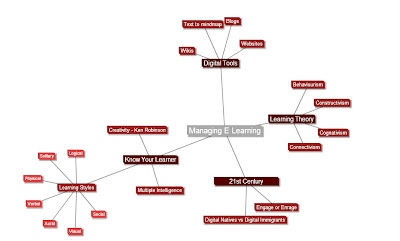Concept mapping is a great tool that can be used when introducing a new topic and it can be referred to throughout the unit to keep learners on track. Concept maps are great for students who are visual learners or those who have a global learning preference as they can see the topic as a whole rather than being fed information sequentially. Another great way to use mindmaps is when brainstorming ideas or when guaging learners' prior knowledge for a topic. Bubble.us and text2mindmap are both free sites that provide online concept mapping software that doesn't requrie users to join the site.
After reading many of the blog posts in regard to the concept mapping software, it was evident that the 'Bubbl.us' software was time consuming and not very user friendly so I decided to try the 'text2mindmap' software instead. Initially, this software was very user friendly as all I had to do was replace the text in the sample text outline and then click the 'convert to mindmap' and it was ready to be formatted. Arranging the mindmap was the tricky part and wasn't quite as straight forward as indicated in the instructions, I somehow managed to get all the mindmap centred and easy to read. However, I imagine that twenty-five young students trying to do this all at the same time could become quite challenging.
This tool could be used effectively in the classroom to consolidate and refine information. For example if students were investigating a topic that was complex or had different perspectives then using an expert jigsaw strategy would help students work in expert groups to engage in their assigned area of the topic, gaining a deeper knowledge of it through substantive conversation with peers and then report back their new knowledge to their home group who then work collaboratively to build a concept map on the whole topic. In addition, students may benefit from using online concept mapping as a way of consolidating information and reviewing what has been learned througout a unit or topic.
To return to my synopsis click here
References
Kearsley, G. (2010). The Theory Into Practice Database. Retrieved from http://tip.psychology.org/.Marzano, R. and Pickering, J. (2006). Dimensions of learning teacher’s manual. Heatherton, VIC: Hawker Brownlow Education.


Hey Sheena, Concept Mapping is a great way for teachers and students to organise and store important information. I particularly liked bubble.us as you can create a free account and save concept maps. I think this tool has huge potential in the classroom. Students could be asked to create concept maps on any number of topics. They will need to organise and refine the information to do so. Personally i have found great use in using a concept map as a tool for revision. Thanks Sheena
ReplyDeleteLeah,
ReplyDeleteThanks for your feedback, It's good to know that you found bubble.us so easy to use and that you've used it in the classroom before. I think getting students to create a concept map as a way of revision is a great idea. In fact I think I'll add it to my blog post if that's alright with you.